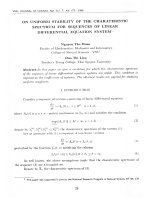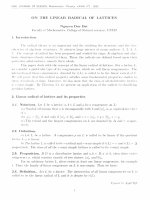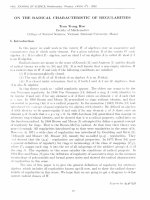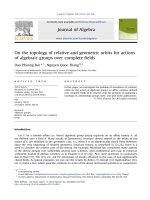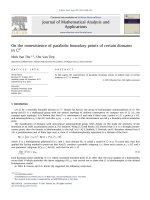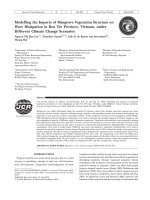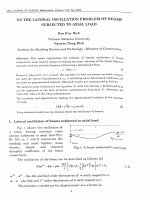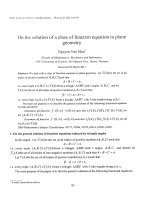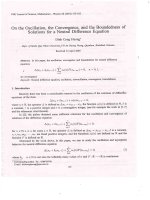DSpace at VNU: On the permanents of matrices with restricted entries over finite fields
Bạn đang xem bản rút gọn của tài liệu. Xem và tải ngay bản đầy đủ của tài liệu tại đây (192.96 KB, 11 trang )
c 2012 Society for Industrial and Applied Mathematics
Downloaded 01/01/13 to 150.135.135.70. Redistribution subject to SIAM license or copyright; see />
SIAM J. DISCRETE MATH.
Vol. 26, No. 3, pp. 997–1007
ON THE PERMANENTS OF MATRICES WITH RESTRICTED
ENTRIES OVER FINITE FIELDS∗
LE ANH VINH†
Abstract. For a prime power q, we study the distribution of permanents of n × n matrices over
a finite field Fq of q elements. We show that if A is a sufficiently large subset of Fq , then the set
of permanents of n × n matrices with entries in A covers all (or almost all) of F∗q . When q = p is a
prime, and A is a subinterval of [0, p − 1] of cardinality |A|
p1/2 log p, we show that the number
of matrices with entries in A having permanent t is asymptotically close to the expected value.
Key words. permanents, matrices with restricted entries, finite fields
AMS subject classifications. 15A15, 15B33, 11L07
DOI. 10.1137/110835050
1. Introduction. Throughout this paper, let q = pr , where p is an odd prime
and r is a positive integer. Let Fq be a finite field of q elements. The prime base
field Fp of Fq may then be naturally identified with Zp = Z/pZ. Let M be an n × n
matrix. Two basic parameters of M are its determinant
n
Det(M ) :=
sgn(σ)
aiσ(i)
i=1
σ∈Sn
and its permanent
n
Per(M ) :=
aiσ(i) .
σ∈Sn i=1
The distribution of the determinant of matrices with entries in a finite field Fq
has been studied by various researchers. Suppose that the ground field Fq is fixed and
M = Mn is a random n × n matrix with entries chosen independently from Fq . If the
entries are chosen uniformly from Fq , then it is well known that
(1.1)
(1 − q −i ) as n → ∞.
Pr(Mn is nonsingular) →
i 1
It is interesting that (1.1) is quite robust. Specifically, Kahn and Koml´os [9] proved
a strong necessary and sufficient condition for (1.1).
Theorem 1.1 (see [9]). Let Mn be a random n × n matrix with entries chosen
according to some fixed nondegenerate probability distribution μ on Fq . Then (1.1)
holds if and only if the support of μ is not contained in any proper affine subfield
of Fq .
∗ Received by the editors May 23, 2011; accepted for publication (in revised form) April 17, 2012;
published electronically July 19, 2012. This research was supported by Vietnam National University,
Hanoi under the project Some problems on matrices over finite fields. An extended abstract of this
work appeared in Proceedings of the European Conference on Combinatorics, Graph Theory and
Applications (EuroComb 2009), Electron. Notes Discrete Math. 34, Elsevier Sci. B.V., Amsterdam,
2009, pp. 519–523 [13].
/>† University of Education, Vietnam National University, Hanoi, Vietnam ().
997
Copyright © by SIAM. Unauthorized reproduction of this article is prohibited.
Downloaded 01/01/13 to 150.135.135.70. Redistribution subject to SIAM license or copyright; see />
998
LE ANH VINH
An extension of the uniform limit to random matrices with μ depending on n was
considered by Kovalenko, Leviskaya, and Savchuk [10]. They proved that the standard
limit (1.1) holds under the condition that the entries mij of M are independent and
Pr(mij = α) > (log n + ω(1))/n for all α ∈ Fq . The behavior of the nullity of Mn for
1 − μ(0) close to log n/n and μ(α) = (1 − μ(0))/(q − 1) for α = 0 was also studied by
Bl¨
omer, Karp, and Welzl [3].
Another direction is to fix the dimension of matrices. For an integer number n
and a subset E ⊆ Fnq , let Mn (E) denote the set of n × n matrices with rows in E.
For any t ∈ Fq , let Dn (E; t) be the number of n × n matrices in Mn (E) having
determinant t. Ahmadi and Shparlinski [1] studied some natural classes of matrices
over finite fields Fp of p elements with components in a given subinterval [−H, H] ⊆
[−(p − 1)/2, (p − 1)/2]. They showed that
2
(2H + 1)n
Dn ([−H, H] ; t) = (1 + o(1))
p
n
(1.2)
q 3/4 . In the case n = 2, the lower bound can be improved to
if t ∈ F∗q and H
H
q 1/2+ε for any constant ε > 0.
Covert et al. [4] studied this problem in a more general setting. A subset E ⊆ Fnq is
called a product-like set if |Hd ∩ E| |E|d/n for any d-dimensional subspace Hd ⊂ Fnq .
Covert et al. [4] showed that
D3 (E; t) = (1 + o(1))
|E|3
q
q 15/8 . Using the
if t ∈ F∗q and E ⊂ F3q is a product-like set of cardinality |E|
geometry incidence machinery developed in [4], and some properties of nonsingular
matrices, the author [12] obtained the following result for higher dimensional cases
(n ≥ 4):
2
|A|n
Dn (A ; t) = (1 + o(1))
q
n
d
q 2d−1 .
if t ∈ F∗q and A ⊆ Fq of cardinality |A|
On the other hand, little has been known about the permanent. The only known
uniform limit similar to (1.1) for the permanent is due to Lyapkov and Sevast’yanov
[11]. They proved that the permanent of a random n × m matrix Mnm with elements
from Fp and independent rows has the limit distribution of the form
lim Pr(Per(Mnm ) = k) = ρm δk0 + (1 − ρm )/p, k ∈ Fp ,
n→∞
where δk0 is the Kronecker delta. Here, as usual, the permanent Per(A) of an n × m
matrix A is defined as the sum of all possible products of n coefficients of A chosen
such that no two of the coefficients are taken from the same row nor from the same
column. The purpose of this paper is to study the distribution of the permanent when
the dimension of matrices is fixed. For any t ∈ Fq and E ⊂ Fdq , let Pn (E; t) be the
number of n × n matrices with rows in E having determinant t. We are also interested
in the set of all permanents, Pn (E) = {Per(M ) : M ∈ Mn (E)}. The first result of this
paper is the following.
Copyright © by SIAM. Unauthorized reproduction of this article is prohibited.
Downloaded 01/01/13 to 150.135.135.70. Redistribution subject to SIAM license or copyright; see />
PERMANENTS OF MATRICES OVER FINITE FIELDS
999
Theorem 1.2. Suppose that q is an odd prime power and gcd(q, n) = 1.
n+1
(a) If E ∩ (F∗q )n = ∅, and |E| > cq 2 , then F∗q ⊆ Pn (E).
q 2/3 , then for each t ∈ F∗q ,
(b) If A ⊆ Fq of cardinality |A|
P3 (A3 ; t) = (1 + o(1))
|A|9
.
q
We have an immediate corollary of Theorem 1.2.
Corollary 1.3. Suppose that q is an odd prime power and gcd(q, n) = 1.
(a) If E ⊂ Fnq of cardinality |E| > nq n−1 , then F∗q ⊆ Pn (E).
1
1
(b) If A ⊂ Fq of cardinality |A|
q 2 + 2n , then F∗q ⊆ Pn (An ).
Note that the bound in the first part of Corollary 1.3 is tight up to a factor of n.
For example, |{x ∈ Fnq : x1 = 0}| = q n−1 and Pn ({x ∈ Fnq : x1 = 0}) = 0. When E is
a product-like set, we can get a positive proportion of the permanents under a weaker
assumption.
Theorem 1.4. Suppose that q is an odd prime power and gcd(q, n) = 1. If
E ⊂ Fnq is a product-like set of cardinality |E|
|Pn (E)|
n2
q 2n−1 , then
(1 + o(1))q.
In the special case E = A × · · · × A, we have the following corollary.
Corollary 1.5. Suppose that q is an odd prime power and gcd(q, n) = 1. If
1
1
A ⊆ Fq of cardinality |A|
q 2 + 2n−1 , then |Pn (An )| (1 + o(1))q.
Furthermore, if we restrict our study to matrices over a finite field Fp of p elements
(p is a prime) with components in a given interval, we obtain a stronger result.
Theorem 1.6. Suppose that q = p is a prime, and entries of M are chosen from
a given interval I := [a + 1, a + b] ⊆ Fp , where
p1/2
b
→ ∞, p → ∞;
log p
then
2
Pn (I n ; t) = (1 + o(1))
bn
p
for any t ∈ Fp .
As we will see in the proof of Theorem 1.6, the method can be applied to a large
variety of multihomogeneous forms. In particular, we have a similar result for the
determinant.
Theorem 1.7. Suppose that q = p is a prime and entries mij of M are chosen
from a given interval I := [a + 1, a + b] ⊆ Fp with
b
→ ∞, p → ∞;
p1/2 log p
then
2
bn
Dn (I ; t) = (1 + o(1))
p
n
for any t ∈ Fp .
Copyright © by SIAM. Unauthorized reproduction of this article is prohibited.
Downloaded 01/01/13 to 150.135.135.70. Redistribution subject to SIAM license or copyright; see />
1000
LE ANH VINH
This result improves [1, Theorem 11] and [12, Theorem 1.5]. The proof of Theorem 1.7 (and the statement for multihomogeneous forms) is left for interested readers.
Throughout the paper, the implied constants in the symbols o and
may depend
on integer parameter n. We recall that the notation U
V is equivalent to the
assertion that the inequality U
c|V | holds for some constant c > 0.
2. Some estimates.
2.1. Incidence estimates. Let f be a complex-valued function on Fnq . The
Fourier transform of f on Fnq with respect to a nontrivial principal additive character
ψ on Fq is given by
fˆ(m) = q −n
f (x)ψ(−x · m).
x∈Fn
q
One of our main tools is a two-set version of the geometric incidence theorem developed
by Hart et al. in [8] (see also [7] for an earlier version and [4] for a functional version
of this theorem). Note that going from a one-set formulation in the proof of Theorem
2.1 in [8] to a two-set formulation is just a matter of inserting a different letter in a
couple of places.
Theorem 2.1 (see [8, Theorem 2.1]). For any E, F ⊂ Fnq , let
νt (E, F ) =
E(x)F (y),
x·y=t
where here and throughout the paper, E(x) denotes the characteristic function of E.
(a) Then
νt (E, F ) = |E||F |q −1 + Rt (E, F ),
(2.1)
where
|Rt (E, F )|2
|E||F |q n−1 ,
if t = 0, and
|R0 (E, F )|2
|E||F |q n .
(b) Moreover, if (0, . . . , 0) ∈ E, then
νt2 (E, F )
(2.2)
|E|2 |F |2 q −1 + |E|q 2n−1
|Fˆ (k)|2 |E ∩ lk |,
k=(0,...,0)
t∈Fq
where lk = {tk : t ∈ F∗q }.
2.2. Arithmetic estimates. The congruence
x1 x2 + x3 x4 ≡ λ (mod p),
(2.3)
where p is a large prime, arises in many problems of number theory (see, for example,
[2, 5] and the references therein). Let Li , Ni , 1 i 4, be integers with 0 Li <
Li + Ni < p. Denote by J(λ) the number of solutions of congruence (2.3) in the box
(2.4)
Li + 1
xi
L i + Ni
(1
i
4).
Ayyad, Cochrane, and Zheng [2] proved that
(2.5)
J(0) =
N1 N2 N3 N4
+ O(
p
N1 N2 N3 N4 log2 p).
Copyright © by SIAM. Unauthorized reproduction of this article is prohibited.
1001
Downloaded 01/01/13 to 150.135.135.70. Redistribution subject to SIAM license or copyright; see />
PERMANENTS OF MATRICES OVER FINITE FIELDS
It has been shown by Garcia [6], in a personal communication, that a similar estimate
holds for J(λ) when λ = 0.
Theorem 2.2 (see [6]). The following asymptotic formula holds for any λ ∈ Fq :
(2.6)
J(λ) =
N1 N2 N3 N4
+ O(
p
N1 N2 N3 N4 log2 p).
Proof. Writing J(λ) in terms of character sums, we have
1
p−1
J(λ) =
χ(x∗1 x∗2 (λ − x3 x4 )),
χ
x1
x2
x3
x4
where χ runs over the set of multiplicative characters modulo p, and the range for
the variables in summations over x1 , x2 , x3 , and x4 is defined by (2.4). In addition,
x∗ denotes the inverse multiplicative of x (mod p). Separating the principal character
χ = χ0 , we have
J(λ) =
N1 N2 N3 N4
+ R(λ).
p
By the Cauchy–Schwarz inequality, we have
R(λ)
1
p−1
χ=χ0
⎛
⎝ 1
p−1
χ(x∗1 x∗2 )
x1
χ=χ0
(2.7) =
J1 −
N12 N22
p−1
x2
χ(λ − x3 x4 )
x3
2
⎞1/2 ⎛
χ(x∗1 x∗2 ) ⎠
x1
x2
1/2
J2 −
x4
N32 N42
p−1
⎝ 1
p−1
2
⎞1/2
χ(λ − x3 x4 ) ⎠
χ=χ0
x3
x4
1/2
,
where, J1 and J2 denote, respectively, the number of solutions of the congruence
x1 x2 ≡ x1 x2 (mod p), L1 + 1
λ − x3 x4 ≡ λ − x3 x4 (mod p), L3 + 1
x1 , x1
x3 , x3
L 1 + N1 , L 2 + 1
L 3 + N3 , L 4 + 1
x2 , x2
x4 , x4
L 2 + N2 ;
L 4 + N4 .
It follows from (2.5) that
(2.8)
(2.9)
N12 N22
p−1
N32 N42
J2 −
p−1
J1 −
N1 N2 log2 p,
N3 N4 log2 p.
The theorem follows immediately from (2.7), (2.8), and (2.9).
Corollary 2.3. For any L1 , L2 , L3 , L4 , N1 , N2 , N3 , N4 with
Ni
→ ∞, p → ∞,
log p
p1/2
let J(λ) be the number of solutions of
x1 x4 + x2 x3 = λ,
where xi ∈ [Li +1, Li +Ni ] (mod p). Then J(λ) = (1+o(1)) N1 N2qN3 N4 for any λ ∈ Fp .
Proof. If [Li + 1, Li + Ni ] (mod p) is not a subinterval of [1, p − 1], we break
it into two disjoint subintervals and an element 0. Applying Theorem 2.2 for these
subintervals, and adding up the results, we obtain the corollary.
Copyright © by SIAM. Unauthorized reproduction of this article is prohibited.
1002
LE ANH VINH
Downloaded 01/01/13 to 150.135.135.70. Redistribution subject to SIAM license or copyright; see />
(2)
2.3. Estimation of matrices with small per-rank. Let Pn (An ) be the
number of n × n matrices M with entries in A such that all (n − 1) × (n − 1) minors
of M have permanent 0.
Lemma 2.4. For any fixed n 2 and A ⊂ Fq , we have
2
Pn(2) (An ) = O(|A|n
−4
).
Proof. The proof proceeds by induction. The base case n = 2 is trivial. Suppose
that the statement holds for n − 1. We show that it also holds for n. For any n × n
matrix M = (xij )1 i,j n with entries in A, let Mst (2 s, t n) be the submatrix
obtained from M by deleting the first row, the sth row, the first column, and the tth
column. Suppose that all (n − 1) × (n − 1) minors of M have permanent 0. We have
two cases.
(1) Suppose that Per(Mst ) = 0 for some 2 s, t n. Without loss of generality,
i, j
2, let M ij be the (n − 1) × (n − 1)
we assume that Per(M22 ) = 0. For 1
minor of M obtained by deleting the ith column and the jth row. Let i1 = 3 − i and
j1 = 3 − j; then
Per(M ij ) = xi1 j1 Per(M22 ) + α
for some α does not depend on xi1 j1 . Therefore, if we fix M22 with Per(M22 ) = 0, there
is at most one choice of xi1 j1 such that Per(M ij ) = 0. Hence, this case contributes at
2
n2 −4
most n−1
= O(|A|n −4 ) matrices whose (n − 1) × (n − 1) minors have zero
2 |A|
permanent.
(2) Suppose that Per(Mst ) = 0 for all 2 s, t n. From the induction hypoth2
(2)
esis, this case contributes at most |A|2(n−1)+1 Pn−1 (An−1 ) = O(|A|2n−1+(n−1) −4 ) =
2
O(|A|n −4 ) matrices whose (n − 1) × (n − 1) minors have zero permanent.
Putting these two cases together, we complete the proof of the lemma.
3. Proof of Theorem 1.2. (a) Fix an a = (a1 , . . . , an ) ∈ E ∩ (F∗q )n . For any
x = (x1 , . . . , xn ), and y = (y1 , . . . , yn ) ∈ E, let M (a; x, y) denote the matrix whose
rows are x, y and (n − 2) a’s. Letting 1 := (1, . . . , 1), x/a := (x1 /a1 , . . . , xn /an ), and
y/a := (y1 /a1 , . . . , yn /an ), we have
n
Per(M (a; x, y)) =
ai Per(M (1; x/a, y/a))
i=1
n
=
n
ai
i=1
i=1
xi
ai
j=i
yj
.
aj
Set
(3.1)
(3.2)
E1 := {(xi /ai )ni=1 : (x1 , . . . , xn ) ∈ E} ,
⎧⎛
⎫
⎞n
⎨
⎬
yi /ai ⎠
: (y1 , . . . , yn ) ∈ E .
E2 := ⎝
⎩
⎭
j=i
i=1
It is clear that |E1 | = |E2 | = |E| (as gcd(n, q) = 1). From (2.1), for any t ∈ F∗q , we
have
(3.3)
νt (E1 , E2 ) = q −1 |E1 ||E2 | + O
q d−1 |E1 ||E2 |
= q −1 |E|2 + O(q (d−1)/2 |E|).
Copyright © by SIAM. Unauthorized reproduction of this article is prohibited.
1003
Downloaded 01/01/13 to 150.135.135.70. Redistribution subject to SIAM license or copyright; see />
PERMANENTS OF MATRICES OVER FINITE FIELDS
This follows that F∗q ⊂ {Per(M (a; x, y)) : x, y ∈ E} if |E| > cq (d+1)/2 for some large
constant c > 0.
(b) For any a, x, y ∈ A3 , let M (a, x, y) denote the 3 × 3 matrix whose rows are
a, x, and y. We have three cases.
(1) Suppose that a ∈ (A ∩ F∗q )3 . Similarly as above, for a fixed a, we have
|{Per(a, x, y) = t : x, y ∈ A3 }| =
|A|6
|A|6
+ O(q|A|3 ) = (1 + o(1))
.
q
q
Since |(A ∩ F∗q )3 | = (1 + o(1))|A|3 ,
(3.4)
|{Per(a, x, y) = t : a ∈ (A ∩ F∗q )3 , x, y ∈ A3 }| = (1 + o(1))
|A|9
.
q
(2) Suppose that a = (0, a2 , a3 ) for some a2 , a3 ∈ A. We have
Per(a, x, y) = x1 (a3 y2 + a2 y3 ) + y1 (a3 x2 + a2 x3 ).
Therefore, for any choice of a2 , a3 , x2 , x3 , y1 , y2 , y3 , there is at most one possibility of
x1 such that Per(a, x, y) = t (t ∈ F∗q ). This implies that
|{Per(a, x, y) = t : a = (0, a2 , a3 ), x, y ∈ A3 }| = O(|A|7 ).
(3.5)
(3) Suppose that a = (0, 0, a3 ) for some a3 ∈ A. We have
Per(a, x, y) = a3 (x1 y3 + x2 y1 ).
Therefore, for any choice of x1 , y3 , x2 , y1 , there is at most one possibility of a3 such
that Per(a, x, y) = t (t ∈ F∗q ). This implies that
|{Per(a, x, y) = t : a = (0, 0, a3 ), x, y ∈ A3 }| = O(|A|6 ).
(3.6)
Putting (3.4), (3.5), and (3.6) together, we have
P3 (A3 ; t) = (1 + o(1))
if |A|
|A|9
|A|9
+ O(|A|7 ) = (1 + o(1))
q
q
q 2/3 . This completes the proof of Theorem 1.2.
4. Proof of Theorem 1.4. Since E is a product-like set, E ∩ (F∗q )n = ∅. Fix
an a ∈ E ∩ (F∗q )n . Define E1 and E2 as in (3.1) and (3.2), respectively. Similarly to
section 3, we have
Pn (E; t)
(4.1)
|{x · y : x ∈ E1 , y ∈ E2 }|.
Removing (0, . . . , 0) from E does not increase the lower bound of Pn (E; t), so we may
assume that (0, . . . , 0) ∈ E. From (2.2), we have
νt2 (E1 , E2 )
t∈Fq
|E1 |2 |E2 |2 q −1 + |E1 |q 2n−1
|E2 (k)|2 |E1 ∩ lk |.
k=(0,...,0)
Copyright © by SIAM. Unauthorized reproduction of this article is prohibited.
Downloaded 01/01/13 to 150.135.135.70. Redistribution subject to SIAM license or copyright; see />
1004
LE ANH VINH
Since E is product-like, so is E1 (note that E1 is obtained from E by scaling). Hence,
|E1 ∩ lk | |E1 |1/n . It follows that
1
νt2 (E1 , E2 )
|E1 |2 |E2 |2 q −1 + O |E1 |1+ n q 2n−1
|E2 (k)|2
k
t∈Fq
1
= |E1 |2 |E2 |2 q −1 + O |E1 |1+ n q n−1
|E2 (y)|2
y
4 −1
= |E| q
(4.2)
+ O(|E|
1
2+ n
n−1
q
),
where the second line follows from Plancherel’s theorem, and the last line follows from
|E1 | = |E2 | = |E|. Applying the Cauchy–Schwarz inequality, we have
(4.3)
⎛
|E|4 = |E1 |2 |E2 |2 = ⎝
⎞2
vt (E1 , E2 )⎠
νt2 (E1 , E2 ).
|{x · y : x ∈ E1 , y ∈ E2 }|
t∈Fq
t∈Fq
It follows from (4.2) and (4.3) that
(4.4)
|{x · y : x ∈ E1 , y ∈ E2 }|
|E|4
|E|4 q −1
+
1
O(|E|2+ n q n−1 )
=
q
1+O
qn
.
1
|E|2− n
Theorem 1.4 now follows immediately from (4.1) and (4.4).
5. Proof of Theorem 1.6. The proof proceeds by induction. The case n = 2
follows from Theorem 2.2. Let M = (xij )1 i,j 3 be a 3 × 3 matrix with entries in
[a + 1, a + b]. We have two cases.
(1) If x33 = 0, then we can write
x13 x31
x33
x13 x31 x23 x32
−2
.
x33
x11 +
Per(M ) = x33
x22 +
x23 x32
x33
+ x12 +
x13 x32
x33
x21 +
x23 x31
x33
Hence, Per(M ) = t if and only if
x13 x31
x23 x32
x22 +
x33
x33
tx33 − 2x13 x31 x23 x32
.
=
x233
x11 +
+ x12 +
x13 x32
x33
x21 +
x23 x31
x33
Since
xij +
xi3 x3j
xi3 x3j
xi3 x3j
∈ a+
,a +
+b
x33
x33
x33
(mod p),
1
i, j
2,
it follows from Corollary 2.3 that, for any fixed ai3 , a3j ∈ A, 1 ≤ i, j ≤ 3, there are
(1 + o(1))b4 /p choices of x11 , x12 , x21 , and x22 such that Per(M ) = t. Therefore, this
case contributes
(1 + o(1))(b − I(0))b4 b4 /p = (1 + o(1))b9 /p
matrices having permanent t, where I(0) = 1 if 0 ∈ I and I(0) = 0 otherwise.
Copyright © by SIAM. Unauthorized reproduction of this article is prohibited.
1005
PERMANENTS OF MATRICES OVER FINITE FIELDS
Downloaded 01/01/13 to 150.135.135.70. Redistribution subject to SIAM license or copyright; see />
(2) If x33 = 0, then
Per(M ) = x32 (x11 x23 + x21 x13 ) + x31 (x22 x23 + x13 x22 ).
If x11 = 0, there are at most b7 choices of the remaining entries such that Per(M ) = t.
If x11 = 0, there is at most one choice of x23 such that x11 x23 + x21 x13 = 0. If
x11 x23 + x21 x13 = 0, there is at most one choice of x32 such that Per(M ) = t. Thus,
this case contributes at most 3b7 matrices having permanent t.
p log2 p, putting these two cases together, we have
Since b2
P3 (I 3 ; t) = (1 + o(1))b9 /p.
Suppose that the statement holds for n − 2
2. We show that it also holds
for n. For any n × n matrix M = (xij )1 i,j n with entries in [a, a + b], let M be the
submatrix obtained from M by deleting the first two rows and two columns, and let
Mst (3 s, t n) be the submatrix obtained from M by deleting the first row, the
second row, the sth row, the first column, the second column, and the tth column.
Choose entries of M randomly from the interval [a + 1, a + b]. We have three cases.
i,
(A) Suppose that per(M ) = 0. For any choice of x1i , x2i , xj1 , xj2 , xij (3
j n), we can write
Per(M ) = Per(M )(x11 x22 + x12 x21 ) + v11 x11 + v12 x12 + v21 x21 + v22 x22 + v
for some fixed v11 , v12 , v21 , v22 , and v (depending on chosen entries of M ). Hence,
Per(M ) = t if and only if
x11 +
v22
Per(M )
x22 +
v11
Per(M )
v21
v21
x21 +
Per(M )
Per(M )
v11 v22 + v21 v12
t−v
−
.
=
Per(M )
(Per(M ))2
+
x12 +
Since
xij +
vij
vij
vij
∈ a+
,a+
+ b (mod p),
Per(M )
Per(M )
Per(M )
it follows from Corollary 2.3 that there are (1 + o(1))b4 /p choices for x11 , x12 , x21 , x22 .
Therefore, this case contributes
2
2
(b(n−2) − Pn−2 (I n−2 ; 0))b4(n−2) (1 + o(1))
bn
b4
= (1 + o(1))
p
p
−(1 + o(1))Pn−2 (I n−2 ; 0)
b4n−4
p
matrices having permanent t.
(B) Suppose that Per(M ) = 0 and Per(Mst ) = 0 for some 3 s, t n. Without
loss of generality, we may assume that Per(M33 ) = 0. For any choice of x1i , x2i , xi1 , xi1
(3 i n), we can write
Per(M ) = v11 x11 + v12 x12 + v21 x21 + v22 x22 + v,
where v11 , v12 , v21 , v22 , and v depend on xij , i, j ≥ 3. By factoring Per(M ) by rows,
we have
(5.1)
v11 = x23 (x32 Per(M33 ) + α) + β,
Copyright © by SIAM. Unauthorized reproduction of this article is prohibited.
Downloaded 01/01/13 to 150.135.135.70. Redistribution subject to SIAM license or copyright; see />
1006
LE ANH VINH
where α does not depend on x23 , x32 and β does not depend on x23 . Now, suppose
that Per(M ) = t. For any fix x1i , xi1 , x2j , xj2 (i
3, j
4), there is at most one
possibility of x32 such that x32 Per(M33 ) + α = 0. Besides, if x32 Per(M33 ) + α = 0,
there is at most one possibility of x23 such that v11 = 0. Hence, there are at most
2b possibilities of (x23 , x32 ) such that v11 = 0. From (5.1), if v11 = 0, there are at
most b3 possibilities of (x11 , x12 , x21 , x22 ) such that Per(M ) = t. Therefore, this case
contributes at most
(2)
(Pn−2 (I n−2 ; 0) − Pn−2 (I n−2 ))(2b4(n−2)−1 b4 + b4(n−2) b3 )
(2)
= 3b4n−5 (Pn−2 (I n−2 ; 0) − Pn−2 (I n−2 ))
matrices having permanent t.
(C) Suppose that Per(Mst ) = 0 for all 3 s, t n. It is trivial that there are at
most b4(n−2)+4 choices of a1i , a2i , ai1 , ai2 , 1 ≤ i ≤ n, such that Per(M ) = t. Therefore,
this cases contributes at most
(2)
b4n−4 Pn−2 (I n−2 )
matrices having permanent t.
Putting all three cases together, we have
2
b4n−4
+ 3b4n−5
p
bn
+ O Pn−2 (I n−2 ; 0)
Pn (I ; t) = (1 + o(1))
p
n
(5.2)
(2)
+ O(b4n−4 Pn−2 (I n−2 )).
From the induction hypothesis,
(5.3)
2
Pn−2 (I n−2 ; 0) = O(b(n−2) /p),
and from Lemma 2.3,
(5.4)
(2)
Pn−2 (I n−2 ) = O(b(n−2)
2
−4
).
It follows immediately from (5.2), (5.3), and (5.4) that
2
Pn (I n ; t) = (1 + o(1))
bn
p
whenever b/p1/2 log p → ∞, completing the proof of the theorem.
Acknowledgment. The author would like to thank Victor Garcia for kindly
granting his permission to present Theorem 2.2 here.
REFERENCES
[1] O. Ahmadi and I. E. Shparlinski, Distribution of matrices with restricted entries over finite
fields, Indag. Math. (N.S.), 18 (2007), pp. 327–337.
[2] A. Ayyad, T. Cochrane, and Zh. Zheng, The congruence x1 x2 ≡ x3 x4 (mod p), the equation
x1 x2 = x3 x4 , and mean values of character sums, J. Number Theory, 59 (1996), pp. 398–
413.
¨ mer, R. Karp, and E. Welzl, The rank of sparse random matrices over finite fields,
[3] J. Blo
Random Structures Algorithms, 10 (1997), pp. 407–419.
Copyright © by SIAM. Unauthorized reproduction of this article is prohibited.
Downloaded 01/01/13 to 150.135.135.70. Redistribution subject to SIAM license or copyright; see />
PERMANENTS OF MATRICES OVER FINITE FIELDS
1007
[4] D. Covert, D. Hart, A. Iosevich, D. Koh, and M. Rudnev, Generalized incidence theorems,
homogeneous forms and sum-product estimates in finite fields, European J. Combin., 31
(2010), pp. 306–319.
[5] M. Z. Garaev and V. C. Garcia, The equation x1 x2 = x3 x4 + λ in fields of prime order and
applications, J. Number Theory, 128 (2008), pp. 2520–2537.
[6] V. C. Garcia, Personal communication, 2009.
[7] D. Hart and A. Iosevich, Sums and products in finite fields: An integral geometric viewpoint,
in Radon Transforms, Geometry, and Wavelets, Contemp. Math. 464, Amer. Math. Soc.,
Providence, RI, 2008, pp. 129–135.
[8] D. Hart, A. Iosevich, D. Koh, and M. Rudnev, Averages over hyperplanes, sum-product
theory in vector spaces over finite fields and the Erd¨
os–Falconer distance conjecture, Trans.
Amer. Math. Soc., 363 (2011), pp. 3255–3275.
´ s, Singularity probabilities for random matrices over finite fields, Com[9] J. Kahn and J. Komlo
bin. Probab. Comput., 10 (2001), pp. 137–157.
[10] I. N. Kovalenko, A. A. Leviskaya, and M. N. Savchuk, Selected Problems in Probabilistic
Combinatorics, Naukova Dumka, Kiev, Ukraine, 1986 (in Russian).
[11] L. A. Lyapkov and B. A. Sevast’yanov, Limit distribution of the probabilities of the permanent of a random matrix in the field GF(p), Diskr. Mat., 8 (1996), pp. 3–13 (in Russian).
English translation in Discrete Math. Appl., 6 (1996), pp. 107–116.
[12] L. A. Vinh, On the distribution of determinants of matrices with restricted entries over finite
fields, J. Combin. Number Theory, 1 (2009), pp. 203–212.
[13] L. A. Vinh, On the distribution of permanents of matrices over finite fields, in Proceedings of
the European Conference on Combinatorics, Graph Theory and Applications (EuroComb
2009), Electron. Notes Discrete Math. 34, Elsevier Sci. B.V., Amsterdam, 2009, pp. 519–
523.
[14] L. A. Vinh, Singular matrices with restricted rows in vector spaces over finite fields, Discrete
Math., 312 (2012), pp. 413–418.
Copyright © by SIAM. Unauthorized reproduction of this article is prohibited.
